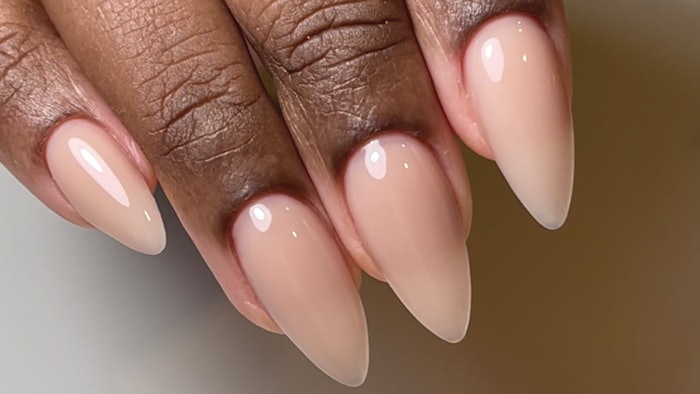
By Candice Idehen
Have you wondered about hard gel? How to use it, how it is different than gel polish? Or maybe you are tired of acrylic and bead ratios. Gain a clear understanding of what hard gel is, how it can be used and what it can do.
What Is Hard Gel?
This is a common question I get asked, and I would like to answer it by explaining what it is not: It is not flexible, it does not soak off, and it does not come in a gel polish bottle. Although you may hear often about “BIAB” or Builder in a Bottle, it is not the traditional hard gel.
Hard gel cannot be soaked off because solvents cannot penetrate hard gel. This means that hard gel forms an impermeable bond on the natural nail—protecting it from breaking down or being penetrated by any substance including acetone—which makes it durable and excellent at protecting the natural nail.
You can use hard gel to overlay natural nails, sculpt extensions and repair broken nails. It is great to overlay clients who are transitioning from acrylic, want to strengthen their natural nails, want extensions or longer nails, or have weak and brittle nails that need more support and structure. If you are removing acrylic from a client, hard gel is the best product to use as it will provide more support.
Hard gel comes in many consistencies depending on your needs. There are builder gels, sculpting gels and other types of hard gels. What differentiates the products are the viscosity or consistency, how the gel moves and their use. Hard gels can be slow moving, fast moving or stationary. The ability for the hard gel to move or flow on the nail is usually denoted as self-leveling. I use self-leveling gels because they are easier to use and require less manipulation by the technician.
Gels that do not self-level require more manipulation and filing to create a smooth, even surface. You want to opt for a self-leveling gel to eliminate the need to finish file and reduce your service time.
Builder gels and slower-moving gels are ideal for sculpting the free edge of nail extensions. They allow you to create a sound structure that is strong enough to support the body of the nail without breaking. Builder gels can traditionally be used to sculpt the free edge as well as pinch the free edge to create a solid C curve to add additional strength and structure to the nail.
Another bonus of hard gel is that you can fill it in, just like you would acrylic. Hard gel plays nice with acrylic, but inversely, I would not fill in hard gel with acrylic. Hard gel is a great option for clients who do not want to soak their nails every service but rather a service they can fill in. This is also a good service for people who are interested in growing their natural nails to longer lengths.
You can use gel polish for a client who has short nails for a few services until they have a bit of a free edge and then transition them to hard gel so their nails are supported to promote growth. For the client who wants long nails but does not want to grow them out naturally, you can opt for nail extensions using forms and hard gel.
To see videos and learn more about sculpting extensions, tips for working with hard gel and must-try products, check out Nailpro's April 2022 digital magazine.












